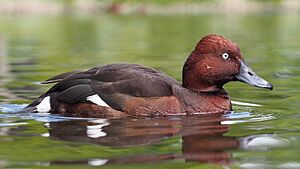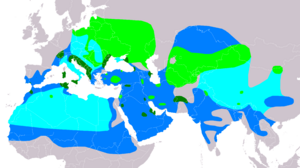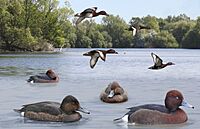Ferruginous duck facts for kids
Quick facts for kids Ferruginous duck |
|
|---|---|
 |
|
| Male | |
 |
|
| Female | |
| Conservation status | |
| Scientific classification | |
 |
|
| Range of A. nyroca Breeding Resident Passage Non-breeding |
The ferruginous duck (Aythya nyroca) is a medium-sized diving duck. It is also known as the ferruginous pochard or white-eyed pochard. These ducks live in parts of Europe, Asia, and Africa. Their scientific name comes from ancient Greek and Russian words for a type of seabird and a duck.
Contents
What Does a Ferruginous Duck Look Like?
Male ferruginous ducks are a rich, dark reddish-brown color. This color is on their head, chest, and sides. They have bright white feathers under their tail. When they fly, you can see their white belly and a white patch under their wings.
Female ferruginous ducks are not as bright. They are duller and more brownish than the males. Males have bright yellow eyes, while females have dark eyes.
Where Do Ferruginous Ducks Live?
Ferruginous ducks like to live in shallow freshwater areas. These places often have lots of plants growing underwater and floating on top. They also like thick plants growing along the edges of the water.
Sometimes, they might use salty or slightly salty water. When they are traveling or spending the winter, they can be found in coastal waters. They also use large, open lagoons.
Where Can You Find Ferruginous Ducks?
Ferruginous ducks breed from Spain and North Africa all the way east to western Mongolia. They also breed south into Arabia. However, in western areas, they are now rare. They have even disappeared from some countries.
During winter, these ducks fly to warmer places. Many spend winter around the Mediterranean Sea and the Black Sea. Some fly south into Africa by following the Nile River. Ducks from eastern areas spend their winter in South and Southeast Asia.
Life and Behavior of Ferruginous Ducks
These ducks like to be with other ducks, but they are not as social as some other duck species. In winter, where there are many of them, they can form large groups. These groups often include other diving ducks, like tufted ducks.
Ferruginous ducks find their partners starting in January. During courtship, the male often curls his tail. This makes the white feathers under his tail dip into the water.
In places where they are common, they might nest together in safe spots like islands. They often do this near gulls. If they are rare, they will nest alone in hidden spots.
Reproduction and Ducklings
Female ducks lay their eggs from late April or early May. The nest is usually on the ground close to the water. Sometimes, they build a nest that floats among the plants in the water.
The eggs are kept warm for about 25 to 27 days. After hatching, the young ducklings can fly when they are about 55 to 60 days old.
What Do Ferruginous Ducks Eat?
These ducks mostly find their food by diving underwater. They also "dabble," which means they tip their bodies upside down to reach food in shallow water.
They mainly eat water plants. They also eat small water animals like snails, water insects, and tiny fish. They often look for food at night.
Protecting Ferruginous Ducks
The ferruginous duck is facing threats. Their favorite homes are being damaged or destroyed by things people do. This includes building dams, draining wetlands, and making the water dirty. Sometimes, people don't manage these areas well.
New types of plants or animals that don't belong there can also harm their homes. For example, a fish called the grass carp eats the plants and small animals that the ducks need for food.
Climate change is also a problem. It can cause more droughts, meaning less water in drier areas where the ducks live. People fishing or boating near the plants where ducks nest can also disturb them. This can make them leave their nesting sites.
Ferruginous ducks are also hunted. Many are shot during their migration in autumn and in their wintering areas. Even though they are protected in most European countries, some hunting still happens by accident or illegally.
There are efforts to protect them. The Agreement on the Conservation of African-Eurasian Migratory Waterbirds (AEWA) helps protect them. In Armenia, their breeding areas are now part of a protected network called Emerald Sites.
Gallery







